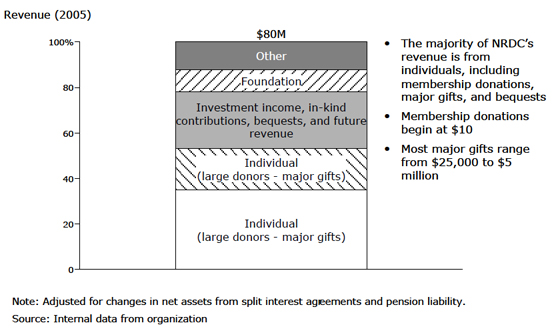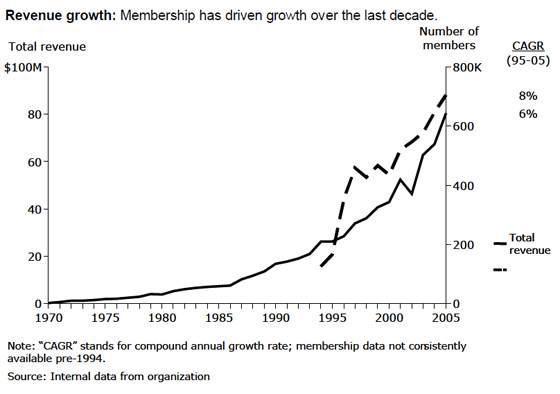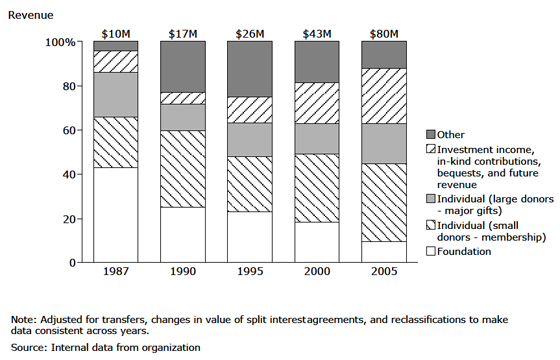Institutions like ours have to make the transition from the personal charisma of the founder to institutionalized charisma of the organization. NRDC has done that.
– Judith Keefer, Director of Finance & Operations
Overview
Related Content
How Nonprofits Get Really BigOrganization Profiles from How Nonprofits Get Really Big
Founded in 1970, NRDC uses legal and scientific expertise along with a base of 1.2 million members and online activists to protect the planet’s wildlife and wild places and to ensure a safe and healthy environment for all living things. The organization is perhaps best known for its involvement in passing the Clean Air Act, and is currently involved in campaigns regarding Navy sonar’s impact on marine mammals, oil drilling in Alaska, and climate change.
With programming spanning air, climate, energy, oceans, health, urban, and nuclear issues, NRDC works to save threatened places and species and to eliminate toxics and pollution. It uses legal and legislative channels to force environmental action and works with members, local and national groups, businesses, and the scientific community to build coalitions for change. NRDC also carries out public campaigns on environmental awareness and action. Due to constraints on the lobbying activities of 501(c)(3) nonprofit organizations, the NRDC Action Fund, an affiliate organization, was created in 1999. The Action Fund works to support pro-environmental legislation and to defeat anti-environment legislation through paid advertising, phone banking, and the mobilization of grassroots pressure.
NRDC’s diversified, largely unrestricted revenue base gives it flexibility to maintain support for critical issues, even as they wax and wane in public or political attention. The Ford Foundation provided its initial funding and foundations have remained an important if declining percentage of its revenue base. In the 1990’s NRDC increased its focus on individual giving, and nearly 70% of NRDC’s revenue currently comes from individuals. The organization’s appeal to individuals is aided by the wide range of environmental issues it works to address. NRDC builds its membership with direct mail and internet campaigns.
Founding date: 1970
Revenue (2005): $80 million
Structure: Single organization
NCCS classification: Environment
Services: Engages in research, public education, legal action, and advocacy to protect the environment
Beneficiaries: Users of open space; the public at large
Leadership (selected): Frances Beinecke, President; John Adams, Founding Director
Address: 40 West 20th Street, New York, NY 10011
Website: www.nrdc.org

Growth Story
- 1970 – John H. Adams and a core of distinguished lawyers found NRDC to create environmental statutes for the first time in history and to bring lawsuits against polluters. Initial funding comes from the Ford Foundation.
- 1985 – NRDC’s membership reaches 50,000.
- 1987 – Foundation grants make up 40% of NRDC’s revenue.
- 1990 – The board and management team undertake a strategic planning process, which results in a re-organization of the internal management structure.
- 1995 – After another strategic planning process, NRDC invests in membership recruitment to support its advocacy agenda. Between 1995 and 1996, membership grows from 175,000 to 350,000.
- 2006 – Founder John Adams steps down as president of NRDC, transferring the reins to Frances Beinecke (formerly NRDC’s executive director). The organization undertakes further strategic planning and launches a multi-year comprehensive fundraising campaign called “Partnership for the Earth.”
Revenue Trends
Revenue growth:

Funding mix:

Actions That Helped Propel Growth in Funding
- Tapped into society’s growing interest in environmental issues. NRDC came onto the scene as environmental issues were becoming increasingly important to Americans.
- Used broad range of programming to appeal to donors. NRDC is known for being a tough advocate with deep expertise across a broad range of environmental issues. This breadth helps NRDC appeal to individuals who want to give to an environmental charity without choosing a specific issue, yet still attract foundations and high net worth individuals with more specific interests.
- Built membership to support increased focus on advocacy efforts. NRDC has shifted over time from pure policy analysis to advocacy. The organization needed a broad base of support for its advocacy efforts, so it invested heavily in cultivating a large membership.
- Maintained continuity and flexibility in leadership roles. John Adams steered NRDC from 1970 to 2005. This continuity provided stability and the opportunity for growth. Both Adams and NRDC’s board supported a decentralized, entrepreneurial culture. This flexibility allowed the organization to address emerging issues, helping it remain relevant within the environmental movement and political landscape.
Funding Challenges
- Overcoming the limited scalability of foundation funding. After 20 years of growth with mainly foundation funding, NRDC’s leadership realized that the organization needed individual donors to spur and sustain growth. The organization has not abandoned foundation funding however. While individuals currently provide 70% of the organization’s revenue, foundation funds still account for a 10% share.
- Addressing the interests of strong donors. NRDC has had to manage the need to respond to the interests of foundations and large donors (two important sources of revenue for NRDC) while keeping with the institution’s strategic goals.

